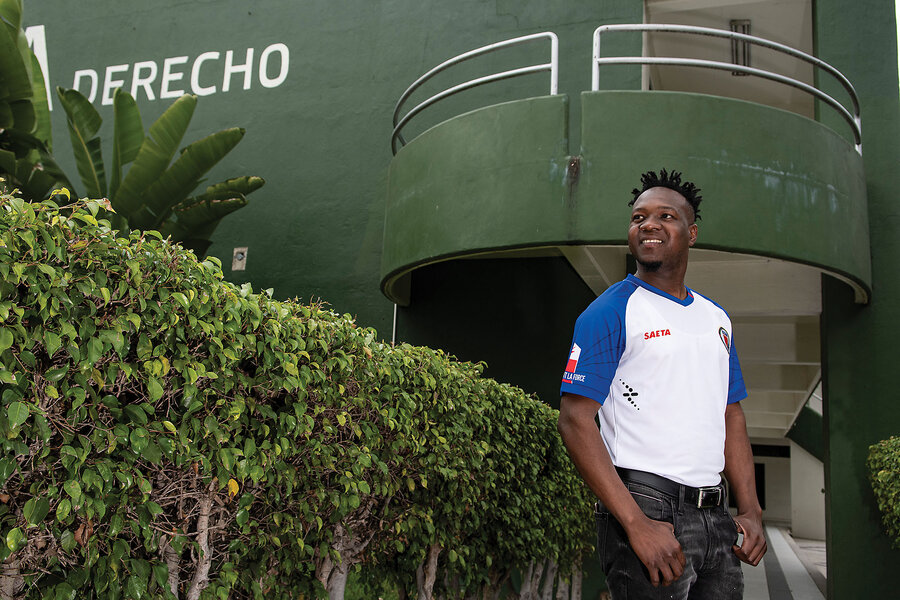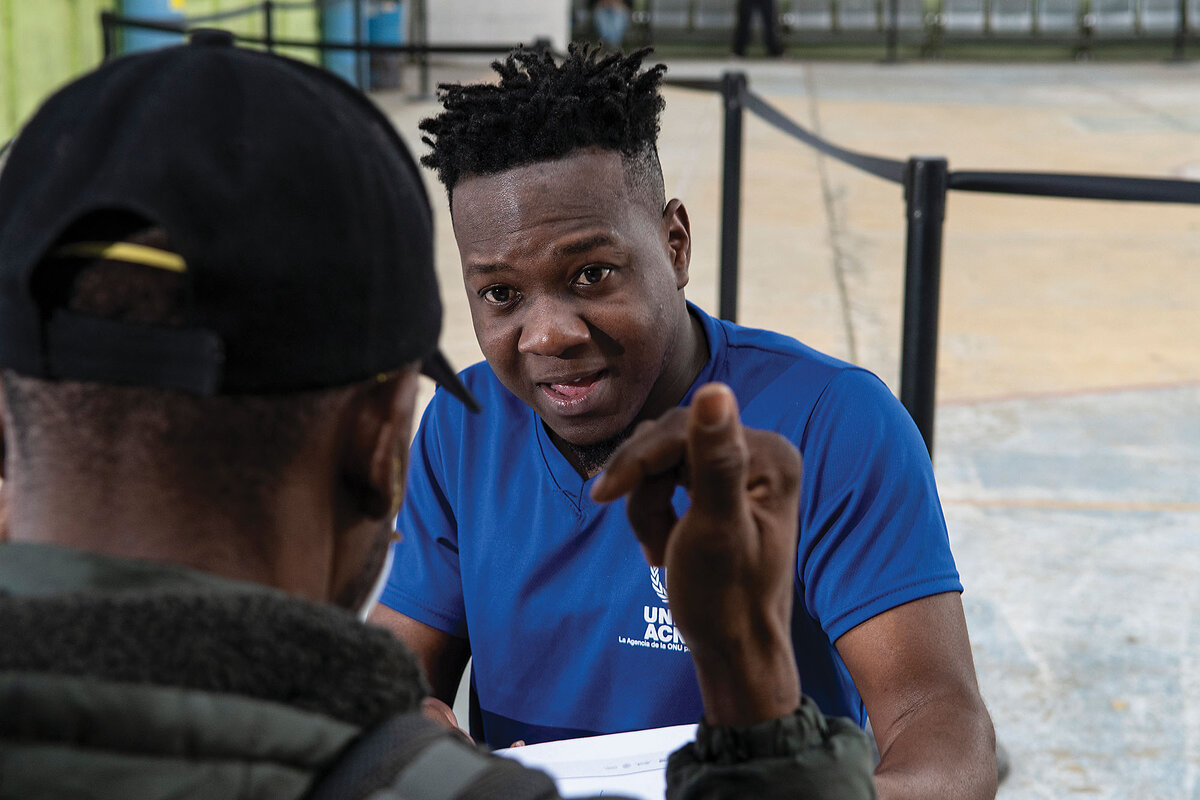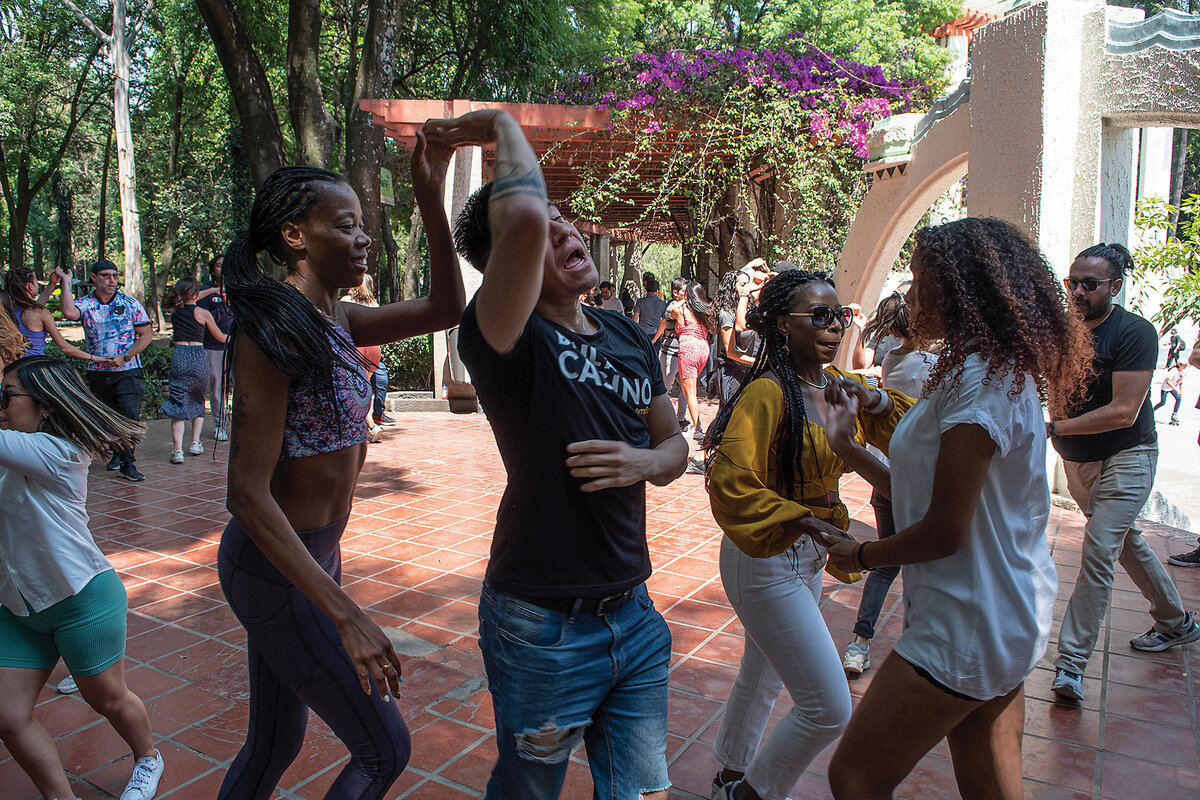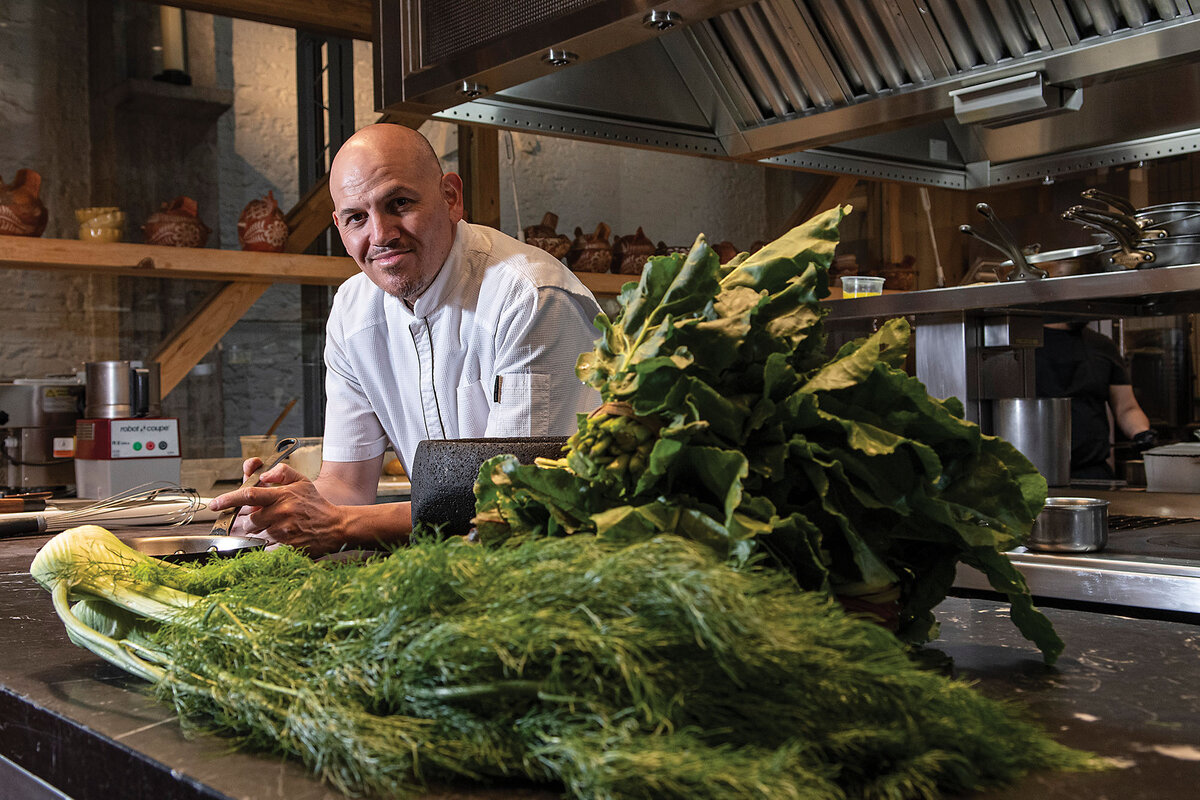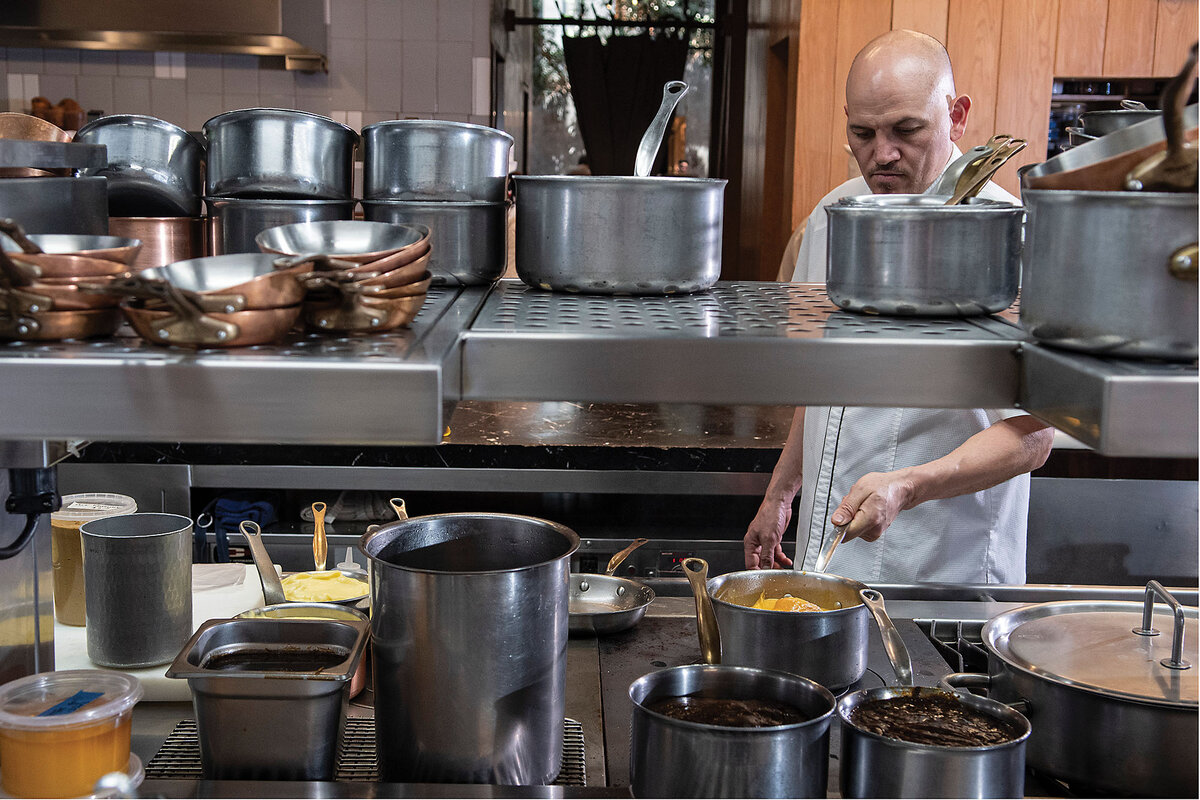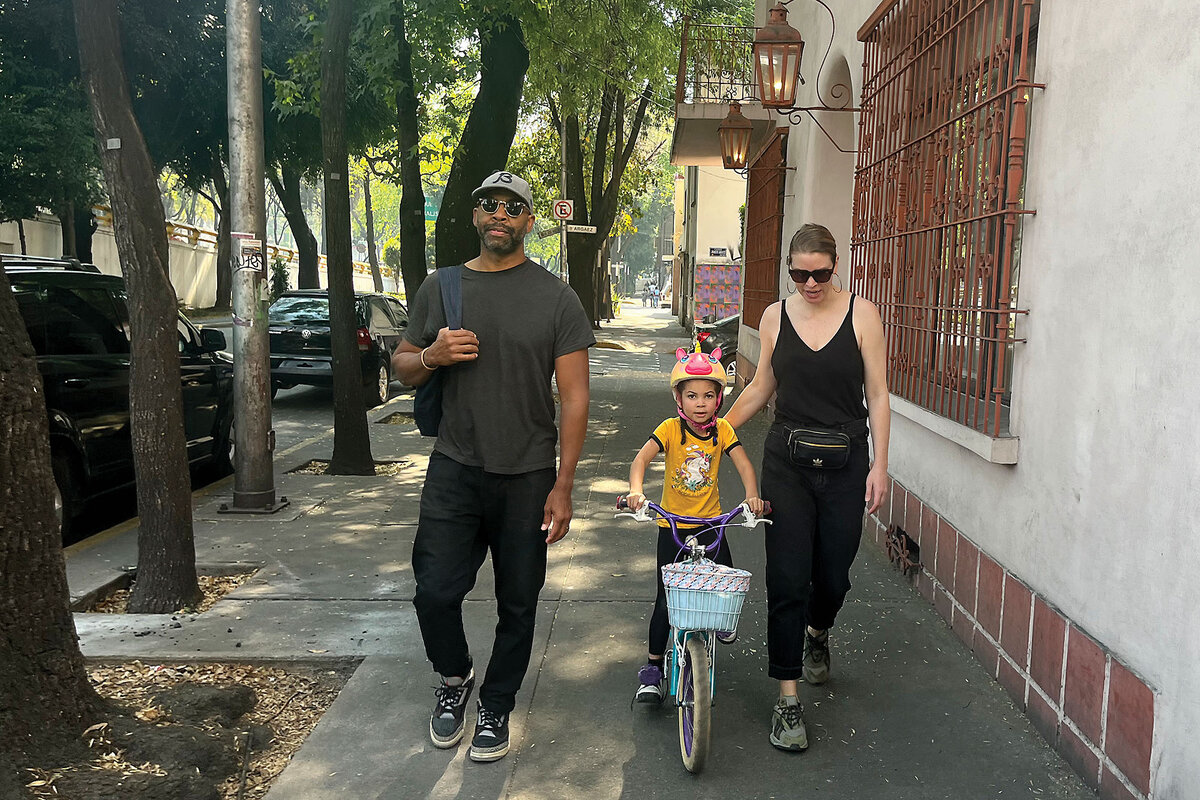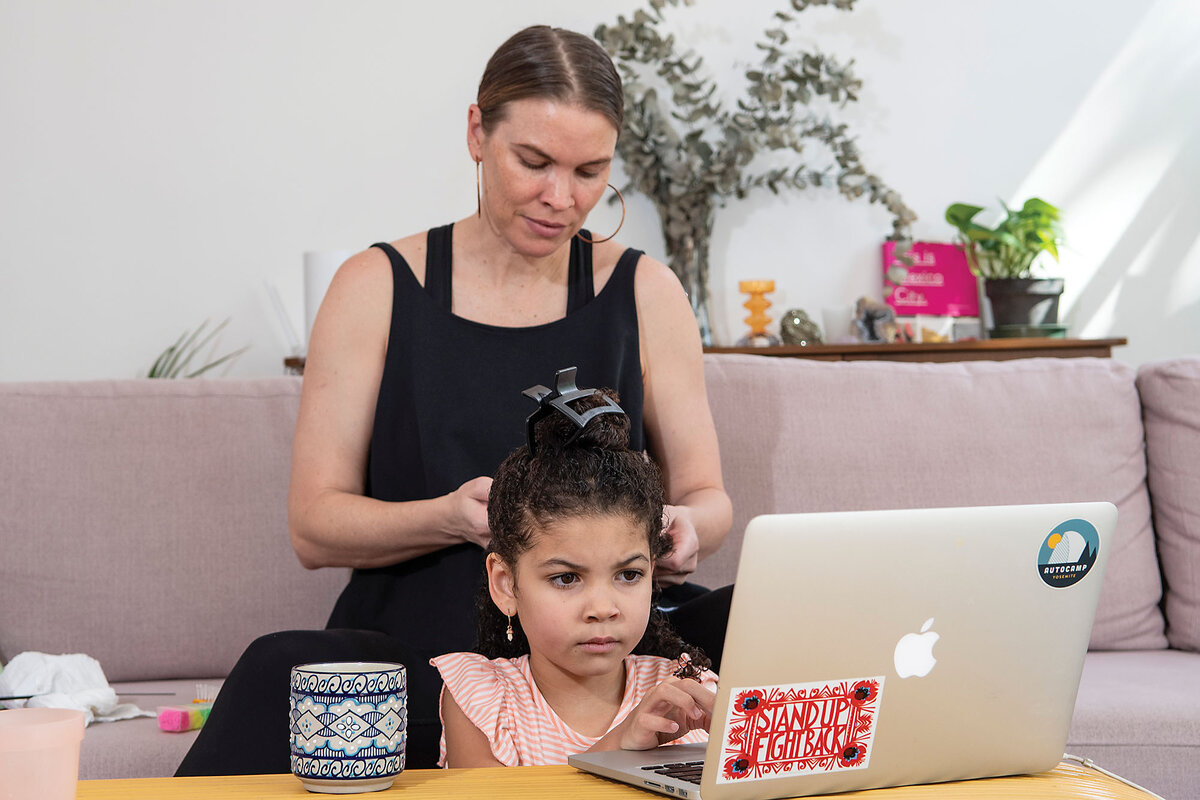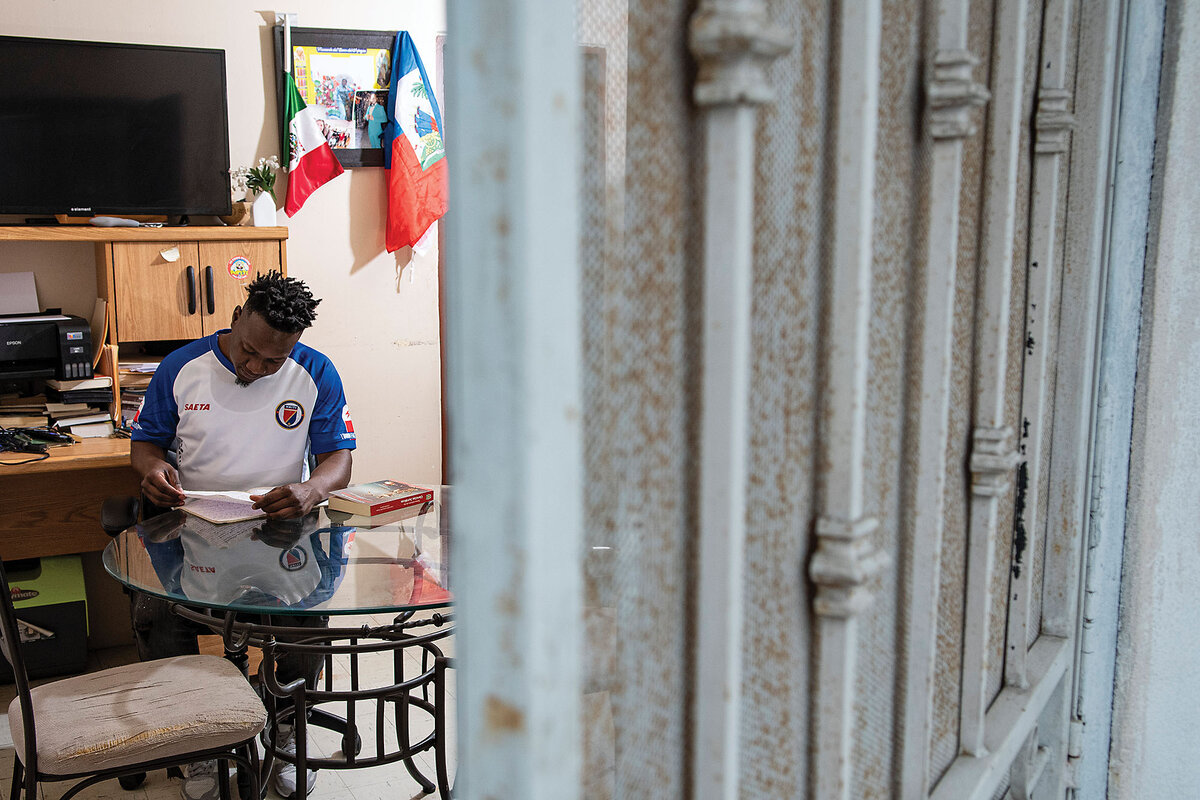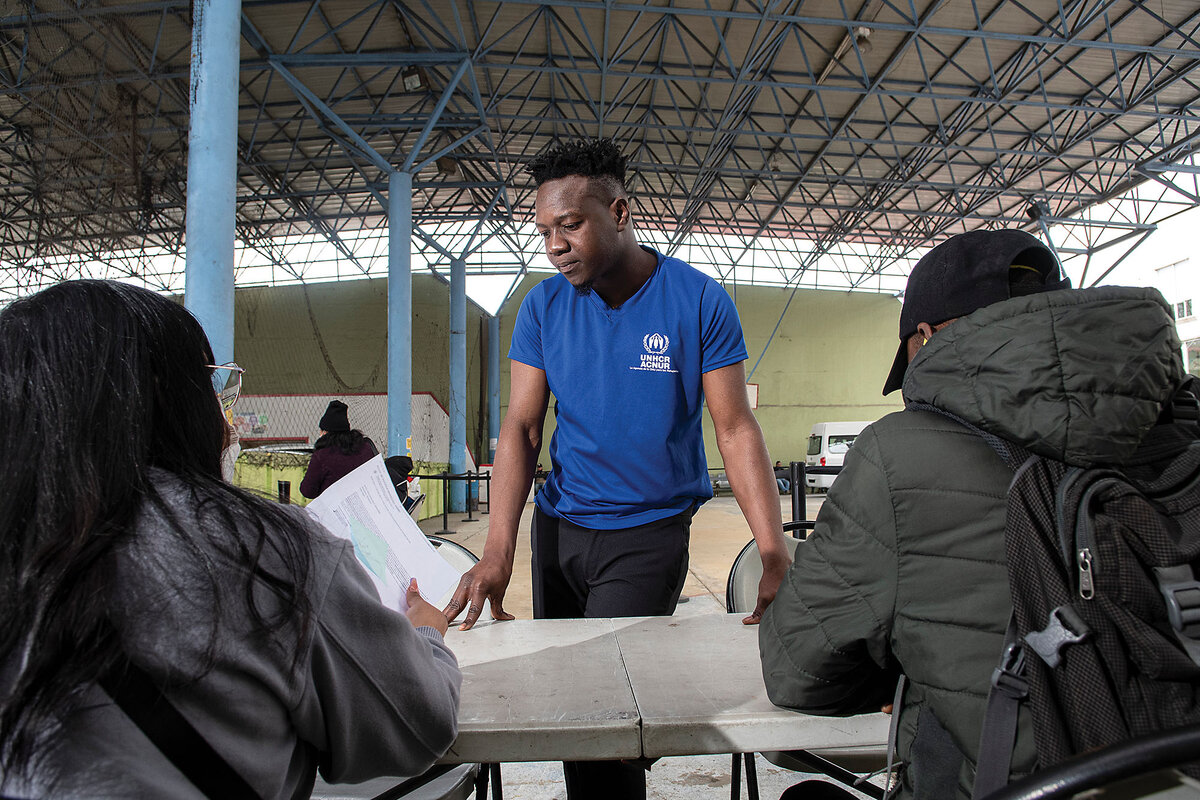These migrants bound for the US border found their dream opportunity in Mexico
Loading...
| MEXICO CITY AND TIJUANA, MEXICO
When Dales Louissaint left Port-au-Prince, Haiti, in 2016 amid growing lawlessness and economic crisis, his sights were set on the United States. For him, the American dream meant learning a new language, going to college, and becoming a lawyer.
Today, he’s safely living out his dream, envisioning even bigger life plans – earning a master’s degree, buying a home, starting a family – and confident they could become a reality.
But instead of in the U.S., he’s making it happen in Mexico.
Why We Wrote This
A story focused onFor many migrants, the United States represents the promised land. But along the way, some have found home – and success – in Mexico.
On a recent rainy morning, Mr. Louissaint weaves his way through a maze of plastic folding tables and chairs on the basketball court outside a Mexican asylum office in Tijuana. As a translator for the United Nations refugee agency (UNHCR), he’s helping migrants – mostly Haitians, with some Cubans, Hondurans, and Syrians – fleeing violence, impunity, and persecution.
He’s constantly flagged down by applicants looking to white-out mistakes on their paperwork (he carries a special pen in his pocket for the purpose) and sits alongside those trying to articulate why they had to leave home.
Mr. Louissaint is no-nonsense in his work, nodding calmly as applicants lob questions at him. Most, he suspects, have their eyes trained on the U.S. as he once did, before he realized he’d likely never attain legal status to study and work in a job like this. “Many end up staying here. And for some, it can work,” he says. “I never want to live in a country other than Mexico.”
To be sure, Mexico faces undeniable challenges. There have been more than 30,000 murders per year for five years straight – a far higher rate than in the U.S. – and gangs hold unchecked control over vast swaths of the country. An estimated 386,000 Mexicans are displaced within the country due to violence. Roughly 60% of laborers work in the informal sector, unable to earn a stable wage. Remaining in Mexico isn’t realistic for all migrants and refugees – or even Mexicans – and the ability to settle here can depend on a person’s place of origin, the threats they’re fleeing, and where in Mexico they land.
Yet as the U.S.-Mexico border takes center stage in the U.S. this year in the lead-up to the presidential election, all of the rhetoric about shutting migrants out ignores the changes taking shape around immigration south of the border.
After generations of being defined as simply a “sending country” or more recently a “transit country” for U.S.-bound migrants, Mexico hit net-zero migration between 2009 and 2014 – with more Mexicans returning to Mexico than migrating to the U.S. That trend started to reverse prior to COVID-19, according to Pew Research Center, but migration remained much lower than levels seen in the 1980s and ’90s, when Mexico faced historic political shifts and acute economic crises.
Global migration stands at an all-time high, almost double what it was in 1990, and that means more people from more places are crossing through Mexico. But it also means more people are staying put – by choice or not – in Mexico, while increasingly Americans are cutting the reverse path and crossing the border headed south.
“Mexico definitely, above all since 2018, has become a destination country,” says María Inés Barrios de la O, professor of migration studies at the College of the Northern Border in Tijuana. That reflects, in part, the fact that people are leaving home for many more reasons than they may have in the past, she says. “It’s not just economic migration, but more forced migration: people leaving contexts of violence, poverty, natural disasters, marginalization,” says Dr. Barrios.
As a result, “the traditional flows from south to north, underdeveloped to developed” are no longer the default migratory paths.
The first part of Eduardo “Lalo” García Guzmán’s life follows that classic migration tale. His reality today is part of Mexico’s new narrative.
“After a few months of being in Mexico, I came to the conclusion that I was falling in love with a country that I’d never known,” says Mr. García, one of Mexico’s top chefs, who was deported twice from the U.S.
He first left Mexico at age 9, crossing the border without documentation to reunite with his father and join him as a migrant farmer. “I wasn’t concerned with success; I just finally felt wanted,” he says of deciding not to try to return to the U.S. following his second deportation, in 2007 at the age of 29.
On a recent morning, Chef García sits at a back corner table inside his airy, artfully decorated Mexico City restaurant Máximo Bistrot, considered one of Latin America’s top dining establishments. The kitchen is bustling as staff moves in fine-tuned chaos, chopping, sautéing, mixing, carrying, and cleaning.
But he is calmly talking business with a former employee, Eleuterio Orea, who worked as a floor manager at Máximo for five years before returning to his small community in Puebla state to pursue projects of his own. He requested today’s meeting to invite Mr. García to an upcoming culinary event he’s organizing, and to tell him about a mezcal project that centers around biodiversity.
By the time they say goodbye, Mr. García has agreed to cook at the event and to list the mezcal on his menu.
For him, this is success. Mr. García made an international name for himself over the past decade as an innovative chef who centers Mexican ingredients in his dishes. But a less high-profile part of his work has been trying to give employees a reason to remain in Mexico – through higher-than-average wages, efforts to promote internally, and opportunities for continuing education.
When we started, “we didn’t quite understand how successful we wanted to be; it was just we wanted to prove a point,” says Mr. García of launching Máximo with his wife, Gabriela López, in 2011. “We started to employ people [who] would have traveled to the U.S. illegally, but instead they stayed in Mexico. Because they had no need to leave. We’re really proud of that.”
Mr. García says many people he’s worked with, like Mr. Orea, have gone back to their villages inspired to become entrepreneurs. One former employee opened a butcher shop, and others sell local pottery and textiles or heirloom tomatoes to top-tier restaurants in the capital. During the pandemic, Mr. García partnered with four former employees who wanted to open their own restaurants, now proudly counting them among the 11 businesses in his restaurant umbrella group, Grupo Maximus.
Laura Tillman, author of “The Migrant Chef: The Life and Times of Lalo García,” says Mr. García is part of a new cohort of Mexican chefs helping change “the manual” for younger generations, who once saw American kitchens as their only viable choice.
The message Mr. García says he is trying to convey: “There is a future in Mexico.”
That means something coming from him.
Mr. García spent his early years like many of the people working for him today. He lived in a small rural town, his family was poor, and his future was seemingly written: He, like countless before him, would migrate to the U.S. He only saw his father three times in the first decade of his life. In 1987, when he was still a boy, his family crossed the U.S. border on foot, to reunite with his dad. Mr. García’s childhood was marked by harvests – picking citrus in Florida, planting onions in Georgia, and collecting apples in Michigan.
He was first deported after driving the getaway car for a robbery as a teen in Georgia. He served a three-year sentence, followed by immediate deportation in 2000.
When he landed in Mexico, he barely recognized this country, and his entire family – including his ailing father – was north of the border. He turned around and went back.
Something changed for him when immigration authorities caught and deported him for a second time, in 2007. Despite his quick ascent in Atlanta kitchens, he had a sensation of being invisible there, he says. “I didn’t feel human in the U.S. I felt like nothing. I felt like I didn’t have a purpose,” he says. “I was very depressed, but extremely relieved,” he says of being deported.
He talks to his employees daily about his experience of living without documentation in the U.S. – he knows he can’t force anyone to extinguish their vision of working in el norte, but he feels his story can provide a reality check. At least once a year, he says, people who know his background approach him to say they can help him get back into the U.S. – that they have a good lawyer who surely could get him pardoned.
“I don’t really feel the need to go back,” he says, despite the fact that his family lives in the U.S. now, with legal status. Instead, they visit him in Mexico. Mr. García has welcomed Mexican employees back after they’ve tried their hand at the American dream, and he also finds himself in recent years welcoming talented people arriving from Venezuela, Argentina, Ecuador, and other politically or economically challenged countries to work in his kitchens. There’s room for them here, too, he says.
“For me it’s super important to stay as long as I can here in this business, to try to promote and teach people that they can do this in a country where people say there’s no success.”
For the Bangs family, Mexico is now central to their notion of success for the future.
When the American family packed its bags in Southern California to move south of the border in 2022, it joined the more than 76,000 Americans receiving temporary and permanent residency visas in Mexico over the past five years.
“Coming to Mexico made me realize that the United States is like a teenager. It’s very ‘me, me, me, me, me,’” says JaQuay Bangs, who moved to the capital from Ventura County, California, with his wife, Margaux, and young daughter. The cost of living and the experience of living abroad were central motivators, but violence in the U.S. – particularly racial violence – played a key role for Mr. Bangs, who is Black.
“The narrative in the U.S. is that everybody wants to get into the U.S., right? But then you come to Mexico City and you’re looking around and you’re like, ‘Oh. People don’t care about the U.S.!’” he says. “I realized I had been caught up in that teenage mentality, too” of seeing the U.S. as the one and only place to be.
Americans have long moved abroad to escape U.S. policies, culture, or the cost of living, from Black Americans heading to France in the first part of the 1900s to draft dodgers during the Vietnam War to retirees flocking to charming and relatively inexpensive San Miguel de Allende and Lake Chapala in Mexico for decades.
During the pandemic, migration from the U.S. to Mexico grew exponentially, with Americans taking advantage of remote work opportunities in a vibrant and more affordable setting. Mexico is also far less polarized around politics and race. And while crime rates are staggering in the country as a whole, in Mexico City crime dropped to roughly eight homicides per 100,000 people in 2023, levels that are safer than in U.S. cities like Portland, Oregon (12 per 100,000), or Dallas (nearly 19 per 100,000).
Americans entering Mexico on first-time temporary and permanent residency visas grew from just over 11,500 in 2019 to almost 20,000 in 2022.
During the pandemic, Mr. Bangs was laid off as head of music for a streaming platform and spent a year searching for work. He later found a job with a startup, only to learn it didn’t have funds to pay for his labor. He quit.
“It was a scary couple of years in terms of stability and financial security,” says Ms. Bangs, who designs kitchens and cabinetry remotely. On top of the high cost of living in their small town, their biracial family was reckoning with the aftermath of the murder of George Floyd, questioning where they fit into their community and country.
“A lot of experiences came up that made me feel, ‘This place isn’t quite what we thought it was,’” she says of their Southern California town. So they decided to change the narrative: The Bangses would move to Mexico City for one year to improve their Spanish and try to have an “adventure,” instead of stressing to make ends meet in an environment that constantly sent them the message that they weren’t valued. That year turned into two.
Sitting in their sunny, third-floor apartment in the leafy Condesa neighborhood in central Mexico City on a recent afternoon, they say a lot has changed. “One thing we underestimated is how good it feels to be away from the polarization of the U.S.,” says Ms. Bangs.
Their daughter, now 6 years old, speaks Spanish fluently and has a little band of friends she bikes part of the way home from her school with each day. Instead of nerves over school shootings or racial microaggressions, the adults are soaking up what feels to them like a culture that sees children as full citizens who deserve love and respect from the entire community.
Mr. Bangs says he didn’t realize in the U.S. how much the question of race weighed on him. In retrospect, he says, “it was difficult, that feeling of just looking over your back all the time.” Here, the first question he’s asked isn’t what sport he plays. He doesn’t watch strangers touch his daughter’s hair with what feels like ridicule. He hasn’t been stopped or followed by police. And he no longer games out scenarios to preserve his own safety, such as having a plan if his daughter runs onto a stranger’s lawn during an evening stroll. (Answer in the U.S.: Beckon to her from the public sidewalk – do not set foot on private property as a Black man.)
“I feel lighter,” he says.
The family realizes Mexico isn’t perfect. Racial bias persists; it’s just not examined in national discourse. A 2017 study found a 52% reduction in educational attainment between the lightest- and the darkest-skinned Mexicans.
The family also recognizes that as foreigners who don’t read the local news daily, they’re living in something of a bubble, shielded from the violence, impunity, and corruption that mark life for so many Mexicans. Crucially, they haven’t been able to secure work and recently decided to return to the U.S. for a job opportunity – but with a game plan to return to Mexico permanently within the next 10 years.
In that transition, the Bangses say their current priority is to preserve habits they’ve formed while living here – a more active presence in the kitchen for Mr. Bangs, a focus on midweek family outings to parks for Ms. Bangs – and to bring them back to the U.S.
“That’s my attitude toward moving back,” says Mr. Bangs. “I want to help” improve our culture back in the U.S., how we interact with our neighbors, what we prioritize in any given day or week, “rather than just be along for the ride.”
“I understand where we want to be in the future,” Mr. Bangs says. “We want to be here in Mexico.”
The Bangses are not alone in that sentiment.
Mr. Louissaint was able to gain residency in Mexico due to his Haitian nationality, which fell under a visa category for humanitarian need. He didn’t have a clear asylum case, and the idea of entering the U.S. without authorization repelled him. “I watched news of people who lived in the country for 20 years ... never getting a pathway to permanent status,” he says. He decided if his goal was to study and make a career for himself, Mexico was the best alternative.
It took him two years to get his paperwork – and language skills – in order to gain acceptance to a local university in Tijuana. And he met helpers along the way, like a stranger who, upon learning of Mr. Louissaint’s desire to study at the Autonomous University of Baja California, put him in touch with his college-aged son for in-person language tutoring.
He’s content he chose Mexico – he’s been treated kindly by locals, found the opportunities that eluded him back home, and loves a job that keeps on getting busier.
Asylum claims inside Mexico have shot up a hundredfold over the past decade. And while whole numbers might pale in comparison with the more than 930,000 new requests for asylum in the U.S. last fiscal year, it’s a data point that continues to grow. In 2023 Mexico received nearly 141,000 asylum applications, a roughly 30% increase from 2022. In 2013, applications were just shy of 1,300.
It’s Mr. Louissaint’s job to give those newcomers his full attention.
He left Haiti during his second semester of college, alone in Port-au-Prince after his parents and most of his siblings had already fled in search of stability and opportunity across the Americas. His loved ones encouraged him to leave the widespread violence behind to pursue his studies in the U.S. His journey took him through Brazil, Peru, Ecuador, and Colombia, across the deadly Darién Gap, up through Central America, and finally to Mexico, where he spent months in a crowded shelter at the border.
His time in the Darién changed him, he says. But it’s also helped him better understand what asylum-seekers are braving to reach this point. “People don’t migrate for happiness; they do it for necessity,” he says. “I won’t ever travel illegally again.” Even back in 2016 – when far fewer took the only land route between South and Central America than the half-million people who crossed in 2023 – it was overrun by deadly risks, from criminals to animals to racing rivers and pounding rain.
He’s held on to the black backpack that he used to carry his belongings through the Darién, an intentional reminder of that experience. Those memories make him feel “strong, and grateful to God. But also, a desire to show the world that someone who makes it through the jungle is going to thrive,” he says, eyeing the tables of asylum applicants waiting nearby.
After arriving in Tijuana, he worked to get his studies in Haiti recognized here, learning Spanish, studying for entry exams, and applying to law school. All while working at least eight hours a day doing home repairs, and later in a factory, often including weekends. On top of his studies, he needed to work to support himself. Last summer, he graduated with honors, soon after hired by the UNHCR.
Though Mexico wasn’t part of his vision when he left Haiti, Mr. Louissaint serves as an example for those who see him assisting and translating at the border today, says Dagmara Mejía, the head of the field office for the UNHCR in Baja California.
“People tend to look at the United States because of the American dream, what they’ve heard about it. But for many the priority is to safely rebuild their lives,” she says. “Seeing someone like Dales, who could find his place and thrive [in Mexico], is inspiring.”
Applicants “like to ask me if I’m happy here,” Mr. Louissaint says. “I can’t share too much, but I will tell them I’ve been here for seven years. I’ve studied. I have a U.S. visa to cross.” He often thinks about a Haitian proverb, he says: “What one person can accomplish, another can accomplish, too.”
Something Mr. Louissaint doesn’t share with many people is that he was recently accepted into a master’s program in humanitarian law in San Diego, just across the border. He hopes to attend this fall if he can come up with the funding. This is part of his upgraded life plan: become adept in U.S. law in addition to Mexican law so that he can serve migrant communities on both sides of the border, while basing himself in Mexico.
“Mexico has helped me a lot, but I’ve also helped Mexico,” he says. “I have something to offer society, and I’m grateful to do it. The opportunities it’s given me are so huge.”




